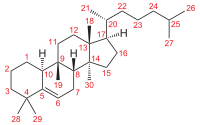
Photo from wikipedia
Cucurbitaceae comprises 800 species, the majority of which are known for their nutritive, economic, and health-promoting effects. This study aims at the metabolome profiling of cucumber (Cucumis sativus) and bottle… Click to show full abstract
Cucurbitaceae comprises 800 species, the majority of which are known for their nutritive, economic, and health-promoting effects. This study aims at the metabolome profiling of cucumber (Cucumis sativus) and bottle gourd (Lagenaria siceraria) fruits in a comparative manner for the first time, considering that both species are reported to exhibit several in-common phytochemical classes and bioactivities. Nevertheless, bottle gourd is far less known and/or consumed than cucumber, which is famous worldwide. A multiplex approach, including HR-UPLC/MS/MS, GNPS networking, SPME, and GC/MS, was employed to profile primary and secondary metabolites in both species that could mediate for new health and nutritive aspects, in addition to their aroma profiling, which affects the consumers’ preferences. Spectroscopic datasets were analyzed using multivariate data analyses (PCA and OPLS) for assigning biomarkers that distinguish each fruit. Herein, 107 metabolites were annotated in cucumber and bottle gourd fruits via HR-UPLC/MS/MS analysis in both modes, aided by GNPS networking. Metabolites belong to amino acids, organic acids, cinnamates, alkaloids, flavonoids, pterocarpans, alkyl glycosides, sesquiterpenes, saponins, lignans, fatty acids/amides, and lysophospholipids, including several first-time reported metabolites and classes in Cucurbitaceae. Aroma profiling detected 93 volatiles presented at comparable levels in both species, from which it can be inferred that bottle gourds possess a consumer-pleasant aroma, although data analyses detected further enrichment of bottle gourd with ketones and esters versus aldehydes in cucumber. GC/MS analysis of silylated compounds detected 49 peaks in both species, including alcohols, amino acids, fatty acids/esters, nitrogenous compounds, organic acids, phenolic acids, steroids, and sugars, from which data analyses recognized that the bottle gourd was further enriched with fatty acids in contrast to higher sugar levels in cucumber. This study provides new possible attributes for both species in nutrition and health-care fields based on the newly detected metabolites, and further highlights the potential of the less famous fruit “bottle gourd”, recommending its propagation.
Journal Title: Foods
Year Published: 2023
Link to full text (if available)
Share on Social Media: Sign Up to like & get
recommendations!